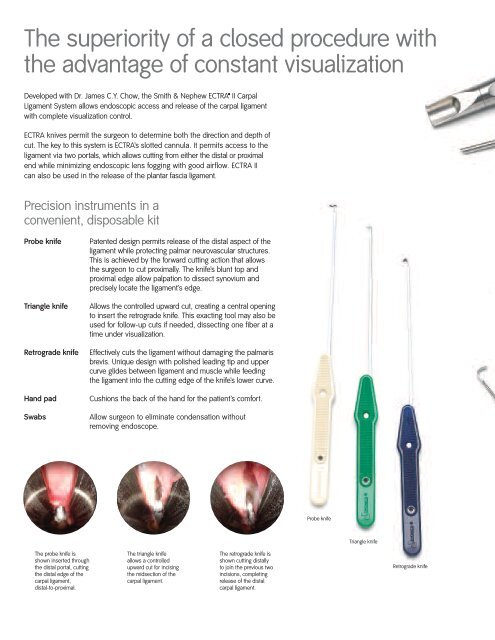A breakthrough in carpal ligament release
A breakthrough in carpal ligament release A breakthrough in carpal ligament release
The superiority of a closed procedure with the advantage of constant visualization Developed with Dr. James C.Y. Chow, the Smith & Nephew ECTRA II Carpal Ligament System allows endoscopic access and release of the carpal ligament with complete visualization control. ECTRA knives permit the surgeon to determine both the direction and depth of cut. The key to this system is ECTRA’s slotted cannula. It permits access to the ligament via two portals, which allows cutting from either the distal or proximal end while minimizing endoscopic lens fogging with good airflow. ECTRA II can also be used in the release of the plantar fascia ligament. Precision instruments in a convenient, disposable kit Probe knife Triangle knife Retrograde knife Hand pad Swabs Patented design permits release of the distal aspect of the ligament while protecting palmar neurovascular structures. This is achieved by the forward cutting action that allows the surgeon to cut proximally. The knife’s blunt top and proximal edge allow palpation to dissect synovium and precisely locate the ligament’s edge. Allows the controlled upward cut, creating a central opening to insert the retrograde knife. This exacting tool may also be used for follow-up cuts if needed, dissecting one fiber at a time under visualization. Effectively cuts the ligament without damaging the palmaris brevis. Unique design with polished leading tip and upper curve glides between ligament and muscle while feeding the ligament into the cutting edge of the knife’s lower curve. Cushions the back of the hand for the patient’s comfort. Allow surgeon to eliminate condensation without removing endoscope. Probe knife Triangle knife The probe knife is shown inserted through the distal portal, cutting the distal edge of the carpal ligament, distal-to-proximal. The triangle knife allows a controlled upward cut for incising the midsection of the carpal ligament. The retrograde knife is shown cutting distally to join the previous two incisions, completing release of the distal carpal ligament. Retrograde knife
Palmar arch suppressor VideoEndoscope Slotted cannula ECTRA II System allows endoscopic carpal tunnel access Palmar arch suppressor VideoEndoscope Serves to depress and protect the palmar arch and receive the obturator tip as it exits the second portal. Prevents light guide from interfering with the forearm by providing a light post on the same side as the direction of view. This endoscope is available in an eyepiece or 35 mm video format. Dissecting obturator Slotted cannula Permits endoscopic surgery via two portals. Detachable handle Conical obturator Detachable handle Dissecting obturator Boat nose obturator Attaches to the obturators, each mating perfectly with the slotted cannula for smooth insertion into the carpal tunnel – dissecting, boat nose and conical. Aggressively clears the underside of the carpal ligament. Provides minimal dissection and easy distal exit. Boat nose obturator Conical obturator Promotes easy distal exit. Probe Hand holder Probe Maintains hand in proper hyperextended position to open tunnel. Snaps on to tray for convenient system storage. Palpates the transverse carpal ligament. Blunt dissector, curved Blunt curved dissector Assists surgeon in identifying/ clearing proximal edge of the transverse carpal ligament. Ragnell retractors Ragnell retractors (2) Provide surgeon with control to hold entry portal open prior to cannula placement.
The superiority of a closed procedure with<br />
the advantage of constant visualization<br />
Developed with Dr. James C.Y. Chow, the Smith & Nephew ECTRA II Carpal<br />
Ligament System allows endoscopic access and <strong>release</strong> of the <strong>carpal</strong> <strong>ligament</strong><br />
with complete visualization control.<br />
ECTRA knives permit the surgeon to determ<strong>in</strong>e both the direction and depth of<br />
cut. The key to this system is ECTRA’s slotted cannula. It permits access to the<br />
<strong>ligament</strong> via two portals, which allows cutt<strong>in</strong>g from either the distal or proximal<br />
end while m<strong>in</strong>imiz<strong>in</strong>g endoscopic lens fogg<strong>in</strong>g with good airflow. ECTRA II<br />
can also be used <strong>in</strong> the <strong>release</strong> of the plantar fascia <strong>ligament</strong>.<br />
Precision <strong>in</strong>struments <strong>in</strong> a<br />
convenient, disposable kit<br />
Probe knife<br />
Triangle knife<br />
Retrograde knife<br />
Hand pad<br />
Swabs<br />
Patented design permits <strong>release</strong> of the distal aspect of the<br />
<strong>ligament</strong> while protect<strong>in</strong>g palmar neurovascular structures.<br />
This is achieved by the forward cutt<strong>in</strong>g action that allows<br />
the surgeon to cut proximally. The knife’s blunt top and<br />
proximal edge allow palpation to dissect synovium and<br />
precisely locate the <strong>ligament</strong>’s edge.<br />
Allows the controlled upward cut, creat<strong>in</strong>g a central open<strong>in</strong>g<br />
to <strong>in</strong>sert the retrograde knife. This exact<strong>in</strong>g tool may also be<br />
used for follow-up cuts if needed, dissect<strong>in</strong>g one fiber at a<br />
time under visualization.<br />
Effectively cuts the <strong>ligament</strong> without damag<strong>in</strong>g the palmaris<br />
brevis. Unique design with polished lead<strong>in</strong>g tip and upper<br />
curve glides between <strong>ligament</strong> and muscle while feed<strong>in</strong>g<br />
the <strong>ligament</strong> <strong>in</strong>to the cutt<strong>in</strong>g edge of the knife’s lower curve.<br />
Cushions the back of the hand for the patient’s comfort.<br />
Allow surgeon to elim<strong>in</strong>ate condensation without<br />
remov<strong>in</strong>g endoscope.<br />
Probe knife<br />
Triangle knife<br />
The probe knife is<br />
shown <strong>in</strong>serted through<br />
the distal portal, cutt<strong>in</strong>g<br />
the distal edge of the<br />
<strong>carpal</strong> <strong>ligament</strong>,<br />
distal-to-proximal.<br />
The triangle knife<br />
allows a controlled<br />
upward cut for <strong>in</strong>cis<strong>in</strong>g<br />
the midsection of the<br />
<strong>carpal</strong> <strong>ligament</strong>.<br />
The retrograde knife is<br />
shown cutt<strong>in</strong>g distally<br />
to jo<strong>in</strong> the previous two<br />
<strong>in</strong>cisions, complet<strong>in</strong>g<br />
<strong>release</strong> of the distal<br />
<strong>carpal</strong> <strong>ligament</strong>.<br />
Retrograde knife




